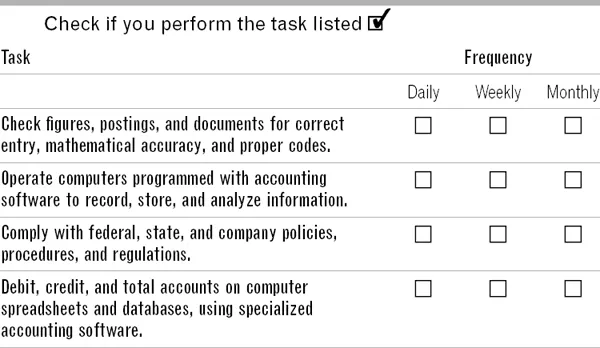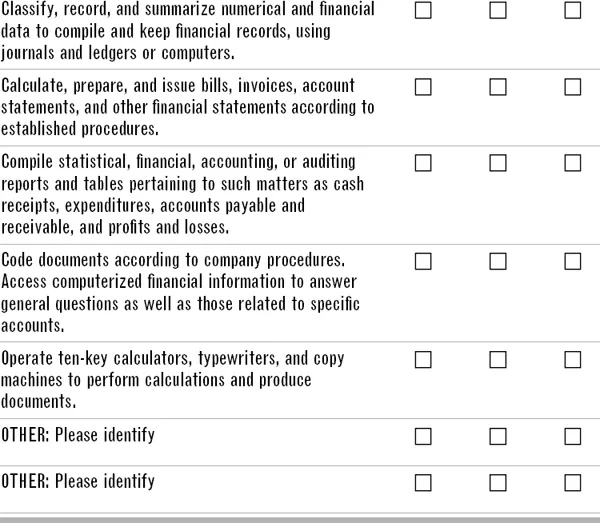Analytic Steps
Identify and determine in detail the particular job duties and requirements for a given job, and the relative importance of these duties and requirements, by undertaking the following steps:
1. Review existing job description, if any.
2. Review public source information and job classification systems.
3. Conduct incumbent surveys and interviews.
4. Conduct supervisor surveys and interviews.
Review Existing Job Description Although your existing job description could well be out of date, it does represent a starting point from which to derive basic technical skills, reporting relationships, and other information.
The existing description also provides you with a baseline against which to measure the current job—in other words, how the job has evolved or materially changed.
Review Public Source Information and Job Classification Systems Looking at how other companies describe jobs can help you write a good job description. Here are some examples of public sources of that information:
The Occupational Information Network (O*NET) System
(www.onetcenter.org)
• Database of occupational requirements and worker attributes
• Comprehensive source of descriptors, with ratings of importance, level, relevance, or extent, for more than nine hundred occupations
• Common language and terminology describing occupational requirements
The Occupational Outlook Handbook (OOH)
(www.bls.gov/oco/home.htm)
• Publication of the U.S. Department of Labor’s Bureau of Labor Statistics
• Includes information about the nature of the work, working conditions, training and education, earnings, and job outlook for hundreds of different occupations
• Released biennially with its companion publication, the Career Guide to Industries
These sources can give you a good idea of how to classify a job.
Conduct Incumbent Surveys and Interviews Find out what the people who have actually been doing the job think about it. What technical skills do they think are required, to whom do they believe they report (irrespective of what an organization chart says), who do they believe reports to them, whom do they interact with on an ongoing basis, how do they believe the job is actually performed, what percentage of their time is being spent on various tasks or undertakings, and so forth?
Help them help you. Most staff members do not think of their jobs in an organized fashion or spend any time trying to measure how many minutes or hours per day they engage in any particular task as opposed to any other. However, that is precisely the information you need to successfully analyze the job and develop a meaningful job description. Consequently, provide incumbents with box checklists, surveys, and questionnaires to fill out.
Box Checklists Here is an example of a portion of a box checklist related to bookkeeping, accounting, or auditing clerks.
Surveys and Questionnaires Here is an example of a portion of a survey related to bookkeeping, accounting, or auditing clerks.
Please specify the tools and equipment you use in your job:
_____ Desktop computers
_____ Scanners
_____ Other:___________________
_____ Other:___________________
Please specify the technology you use in your job:
Accounting software
_____ FlexiLedger software
_____ Intuit QuickBooks
_____ Intuit Quicken software
_____ Quicken Elite software
_____ Other:____________________
_____ Other:____________________
Compliance software
_____ CRSTL Compliance Positioning System
_____ FLS eDP.Payrolltax
_____ Intrax ProcedureNet
_____ Paisley Cardmap
_____ Other:____________________
_____ Other:____________________
Document management software
_____ Accutrac software
_____ OmniRIM software
_____ Records management software
_____ Other:_____________________
_____ Other:_____________________
Enterprise resource planning (ERP) software
_____ AcornSystems Corporate Performance Management
_____ AMS Services AMS Sagitta
_____ Business performance management (BPM) software
_____ Cartesis ES Magnitude
_____ Other:____________________
_____ Other:____________________
Financial analysis software
_____ Auditing software
_____ AuditWare software
_____ MethodWare ProAudit Advisor
_____ RSM McGladrey Auditor Assistant
_____ Other:____________________
_____ Other:____________________
Please explain the following relationships as they are related to your job:
• Supervision given and received
• Relationships with internal people
• Relationships with external people
People who have had the job before are probably your best source of information about the job’s day-to-day responsibilities, so make sure you ask them. You also, however, need to check with their managers, because the job may be changing or the manager may not have liked the way the employee handled the position.
Conduct Supervisor Surveys and Interviews Surveying and interviewing supervisors can provide you with the information you need to determine the core competencies required for the specific job in question. For example, you should discuss the following:
| KNOWLEDGE | |
| Clerical | Knowledge of administrative and clerical procedures and systems such as word processing, managing files and records, stenography and transcription, designing forms, and other office procedures and terminology. |
| Mathematics | Knowledge of arithmetic, algebra, geometry, calculus, statistics, and their applications. |
| English Language | Knowledge of the structure and content of the English language including the meaning and spelling of words, rules of composition, and grammar. |
| Economics and Accounting | Knowledge of economic and accounting principles and practices, financial markets, banking, and analysis and reporting of financial data. |
| Customer and Personal Service | Knowledge of principles and processes for providing customer and personal services. This includes customer needs assessment, meeting quality standards for services, and evaluation of customer satisfaction. |
| Computers and Electronics | Knowledge of circuit boards, processors, chips, electronic equipment, and computer hardware and software, including applications and programming. |
| SKILLS | |
| Mathematics | Using mathematics to solve problems. |
| Reading Comprehension | Understanding written sentences and paragraphs in work-related document... |


